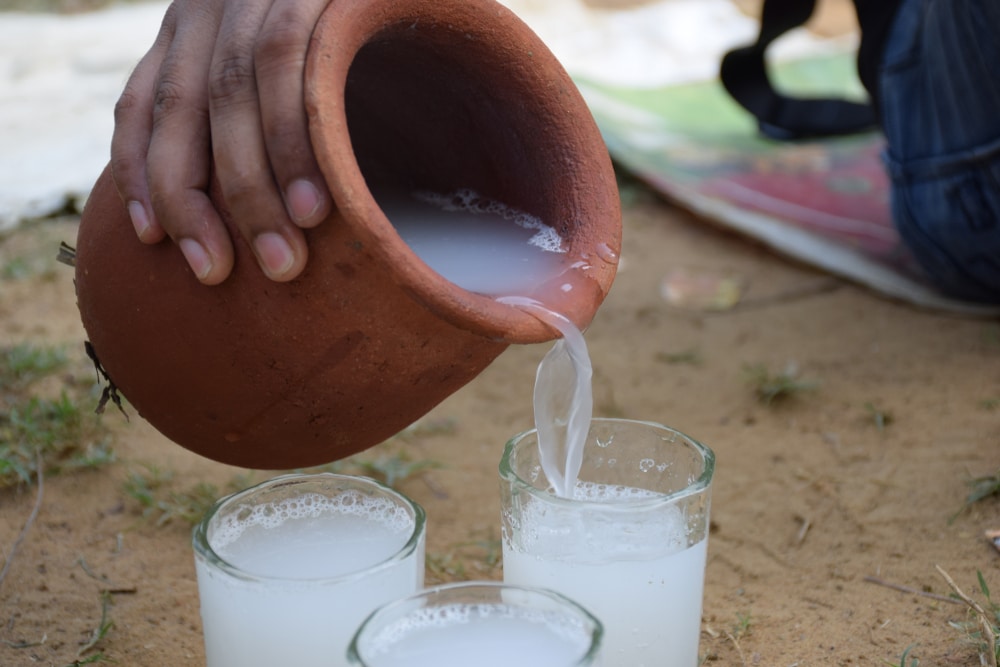How to Make Palm Wine from Scratch: A Step-by-Step Guide

Aromatically sweet and mildly alcoholic, palm wine—also called toddy or tuba—is produced by fermenting the sap tapped from the cut flower or trunk of various palm species. Collected fresh, the sap begins fermenting almost immediately due to wild yeasts, yielding a lightly effervescent drink of about 3–4% ABV within two hours Wikipedia. With longer fermentation (up to 24 hours), acidity and strength increase, creating a more sour wine or even palm vinegar if left further Wikipedia. Traditionally enjoyed across Africa, Asia, and South America, palm wine plays a central role in ceremonies, social life, and local economies iProject Download. Below is a comprehensive, SEO‐optimized guide on ingredients, equipment, tapping methods, fermentation techniques, quality checks, and serving suggestions for crafting your own palm wine from scratch.
What Is Palm Wine?
Palm wine is a naturally fermented beverage made from the sweet sap of palm trees such as coconut (Cocos nucifera), date (Phoenix dactylifera), nipa (Nypa fruticans), and raffia (Raphia spp.) palms Wikipedia. Known locally by names like tuba, toddy, neera, and kallu, it’s prized for its delicate effervescence and nutritional content, including B‐vitamins and amino acids Wikipedia. The sap is channeled directly from a fresh cut on the inflorescence or trunk into a container, capturing the unfermented “toddy” that sweetens over time Comundos.
Essential Equipment & Ingredients
Equipment
- Tapping Tools: Sharp knife or machete for cutting the flower stalk; pegs or stakes to anchor collection cups Comundos
- Collection Containers: Clean clay pots, calabashes, or food‐grade plastic buckets sealed to forestall contamination Comundos
- Filtering Cloth: Cheesecloth or fine mesh to remove debris Comundos
- Storage Vessels: Glass or ceramic jugs for controlled fermentation
Ingredients
- Fresh Palm Sap: Collected at dawn when sugar concentration is highest PubMed
- (Optional) Fresh Yeast Starter: A portion of previous batch to standardize fermentation bioRxiv
- (Optional) Lime (Kanwa): A pinch of food‐grade limestone slows fermentation for sweeter sap Wikipedia
Step-by-Step Preparation
1. Tapping the Palm
- Select the Tree: Choose a healthy palm 15–40 years old for optimal sap yield PubMed.
- Cut the Inflorescence: Using a clean blade, make a fresh slash on the unopened flower stalk.
- Install the Spout: Insert a small bamboo or wooden spout into the cut to guide sap into the container.
- Seal & Sanitize: Cover the top of your collection container to prevent insects and debris Comundos.
2. Collecting Sap
- Morning Harvest: Collect sap within 3–4 hours of tapping; discard any sap older than 12 hours to avoid unwanted microbial growth Wikipedia.
- Daily Tapping: Refresh the cut daily to maintain sap flow, and replace collection vessels with clean ones each harvest Comundos.
3. Fermentation Process
- Immediate Fermentation: Transfer fresh sap into a wide‐mouth fermenter at ambient temperature. Natural yeasts begin converting sugars to alcohol within 30 minutes Dilis Investments Limited.
- Primary Ferment: Cover with cloth; allow to ferment 2–4 hours for sweet, mildly alcoholic toddy (3–4% ABV) Wikipedia.
- Extended Ferment: For stronger wine (up to 6% ABV) or sour flavor, ferment 12–24 hours, stirring occasionally to aerate Dilis Investments Limited.
- Secondary Ferment (Optional): Rack into secondary vessel, leaving sediment behind, and ferment another 1–2 days for clarity.
Quality Control & Flavor Profiles
- Gravity & Alcohol: Use a hydrometer to track specific gravity and alcohol potential. Fresh sap ~1.045 SG yields ~4% ABV in 2 hours ScienceDirect.
- pH & Acidity: Ideal pH drops from ~7.0 to 4.5; over-souring yields vinegar. Taste frequently to avoid spoilage Dilis Investments Limited.
- Aroma & Clarity: Strain through cheesecloth; decant clear wine to reduce off-flavors bioRxiv.
Tips, Variations & Troubleshooting
- Yeast Starter: Adding 5% previous batch sap speeds fermentation and standardizes flavor bioRxiv.
- Temperature Control: Maintain 20–28 °C to balance yeast activity; cooler slows ferment, warmer risks spoilage.
- Flavor Add-ins: Infuse with ginger, pineapple, or honey during secondary ferment for unique regional twists.
- Prevent Contamination: Always sanitize tools and vessels; wild yeasts can produce off-flavors if hygiene lapses.
Serving & Storage
Serving Ideas
- Fresh Toddy: Serve chilled within 2 hours of tapping for a sweet, low-ABV beverage.
- Palm Wine Cocktails: Mix with fruit juices or spices for modern interpretations.
- Cooking Ingredient: Use aged palm wine as a marinade for meat or in local stews.
Storage
- Short-term: Refrigerate up to 48 hours to slow fermentation; consume quickly to enjoy peak flavor.
- Long-term: Distill into palm brandy (e.g., ogogoro) or acidify into vinegar for preservation.
Frequently Asked Questions (FAQs)
- How do I stop my palm wine from turning into vinegar?
Monitor pH and taste every 4–6 hours; refrigerate or distill once desired acidity is reached Dilis Investments Limited. - Can I pasteurize palm wine?
Yes—heat to 65 °C for 15 minutes then cool rapidly to preserve flavor while halting fermentation. - Which palm species produce the best sap?
Coconut, date, raffia, and palmyra palms are popular; choose local species for ease of tapping Mahindra Nursery. - Is palm wine gluten-free?
Yes—made entirely from palm sap and natural yeasts, it contains no grains or additives.
Conclusion
By following these traditional tapping and fermentation techniques—citing best practices from scientific studies and centuries-old traditions—you can craft authentic palm wine at home. Whether you enjoy the fresh, sweet toddy or the aged, tangy brew, palm wine offers a unique glimpse into global culinary heritage and the living traditions of countless cultures. Enjoy responsibly and explore the myriad ways this natural beverage can enrich your table.



